Improved Heart Health, Higher Levels of Education Linked to Lower Dementia Incidence
 American seniors may be developing dementia less frequently and at later stages of life, according to new research published in the New England Journal of Medicine. Since the late-1970s, the risk of developing dementia declined an average of 20 percent every ten years among participants in the Framingham Heart Study. Further, over the course of 30 years, the average age when dementia symptoms began rose by 5 years, from 80 to 85. American seniors may be developing dementia less frequently and at later stages of life, according to new research published in the New England Journal of Medicine. Since the late-1970s, the risk of developing dementia declined an average of 20 percent every ten years among participants in the Framingham Heart Study. Further, over the course of 30 years, the average age when dementia symptoms began rose by 5 years, from 80 to 85.
Researchers could not identify the cause of this decline, but suggested two possible reasons: cardiovascular health and education levels. Among study participants, there was an improvement in overall cardiovascular health during the same time period, and the researchers suggested earlier diagnosis and better treatment of heart disease – including stroke – may have contributed to the lower incidence rate of dementia, especially vascular dementia. The authors also noted that both the decline in new dementia cases and improvement in heart health were limited to study participants with at least a high school diploma. But, since the percentage of seniors who were high school graduates increased over the 30-year study period, rising education levels may explain some of the incidence decline. Interestingly, although a decline in overall dementia incidence was seen, the incidence rates for Alzheimer’s disease did not change.
Even if this study’s incidence decline is representative of the entire U.S. population – including across various racial and ethnic groups – it does not translate to a decline in prevalence. The authors noted that the prevalence of dementia is expected to soar as the population ages and as people live longer. These factors will far outweigh any currently observed decline in incidence.
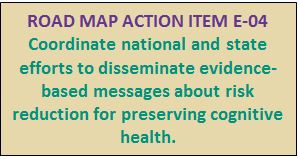 Nonetheless, this study supports the growing scientific consensus that people can take steps – such as managing certain cardiovascular risk factors – to reduce their risk of cognitive decline and possibly dementia. And that points to an important role for public health: disseminating risk reduction messages to promote cognitive health, as recommended in the Public Health Road Map. Public health practitioners could, for example, deliver Brain Health As You Age: You Can Make A Difference!, an evidence-based risk reduction campaign developed by the Administration for Community Living (ACL), the Centers for Disease Control and Prevention (CDC), and the National Institute of Health (NIH). Brain Health As You Age is available in both English and Spanish. Nonetheless, this study supports the growing scientific consensus that people can take steps – such as managing certain cardiovascular risk factors – to reduce their risk of cognitive decline and possibly dementia. And that points to an important role for public health: disseminating risk reduction messages to promote cognitive health, as recommended in the Public Health Road Map. Public health practitioners could, for example, deliver Brain Health As You Age: You Can Make A Difference!, an evidence-based risk reduction campaign developed by the Administration for Community Living (ACL), the Centers for Disease Control and Prevention (CDC), and the National Institute of Health (NIH). Brain Health As You Age is available in both English and Spanish.
Hospitalization More Likely for Those with Undisclosed Dementia Diagnosis
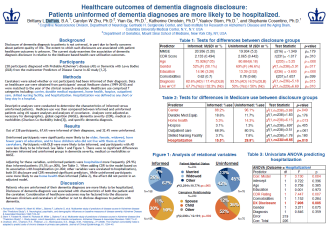 People diagnosed with dementia but not told of their diagnosis have nearly twice as many hospitalizations as those who are diagnosed with dementia and told of their diagnosis, according to a poster presented at the International Neuropsychological Society Annual Meeting earlier this year. By questioning caregivers, the authors determined whether individuals diagnosed with dementia were aware of their diagnosis. The researchers then examined Medicare claims data and found that among study participants, uninformed individuals were hospitalized almost twice as frequently (29.9 percent) as informed individuals (15.5 percent). People diagnosed with dementia but not told of their diagnosis have nearly twice as many hospitalizations as those who are diagnosed with dementia and told of their diagnosis, according to a poster presented at the International Neuropsychological Society Annual Meeting earlier this year. By questioning caregivers, the authors determined whether individuals diagnosed with dementia were aware of their diagnosis. The researchers then examined Medicare claims data and found that among study participants, uninformed individuals were hospitalized almost twice as frequently (29.9 percent) as informed individuals (15.5 percent).
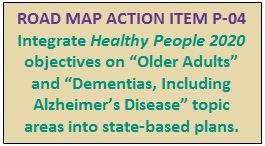 Failure to disclose a dementia diagnosis has major ramifications for the health care system, and this study underscores the need for health care providers to discuss a dementia diagnosis with their patients. To begin addressing this issue, Healthy People 2020 – the 10-year blueprint for improving the nation’s health – includes an objective to increase the proportion of adults with diagnosed Alzheimer’s disease or other dementias, or their caregivers, who are aware of the diagnosis (Objective DIA-1). Timely diagnosis and disclosure offers the best opportunity for better medical care and health outcomes for both individuals with the disease and their caregivers. Failure to disclose a dementia diagnosis has major ramifications for the health care system, and this study underscores the need for health care providers to discuss a dementia diagnosis with their patients. To begin addressing this issue, Healthy People 2020 – the 10-year blueprint for improving the nation’s health – includes an objective to increase the proportion of adults with diagnosed Alzheimer’s disease or other dementias, or their caregivers, who are aware of the diagnosis (Objective DIA-1). Timely diagnosis and disclosure offers the best opportunity for better medical care and health outcomes for both individuals with the disease and their caregivers.
The public health community should integrate this Healthy People 2020 objective into state-based plans, such as falls prevention and preventable hospitalizations. Current baseline data is available, and the Alzheimer’s Association’s Public Health Alzheimer’s Resource Center offers additional information and tools about early detection and diagnosis disclosure.
Now Available: Resources on Data from the 2013 BRFSS Cognitive Module
 Individual fact sheets are now available for the 19 states and Puerto Rico that used the Cognitive Module in their 2013 Behavioral Risk Factor Surveillance System (BRFSS) surveys. With these new data, which were analyzed by the CDC’s Healthy Aging Program, states can see the scope and burden of subjective cognitive decline – the self-reported increase in confusion or memory loss – as well as whether those individuals are talking to a health care provider about their memory problems. Individual fact sheets are now available for the 19 states and Puerto Rico that used the Cognitive Module in their 2013 Behavioral Risk Factor Surveillance System (BRFSS) surveys. With these new data, which were analyzed by the CDC’s Healthy Aging Program, states can see the scope and burden of subjective cognitive decline – the self-reported increase in confusion or memory loss – as well as whether those individuals are talking to a health care provider about their memory problems.
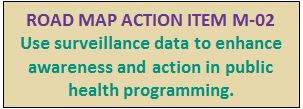 We encourage you to download your state’s fact sheet not only for your own use, but to distribute to health officials, public health practitioners, and state policymakers. Tweet the fact sheet, link to it on your website, blog about it. Data are only useful when used to inform policy and systems change, and that can only happen if the data are widely distributed. We encourage you to download your state’s fact sheet not only for your own use, but to distribute to health officials, public health practitioners, and state policymakers. Tweet the fact sheet, link to it on your website, blog about it. Data are only useful when used to inform policy and systems change, and that can only happen if the data are widely distributed.
And, in case you missed our recent webinar, Memory Loss and the Public Health Burden: Results from the 2013 BRFSS Cognitive Module, a recording is now available. The webinar not only discussed the new 2013 BRFSS findings in depth, but also ways states and localities have used BRFSS cognitive data to educate stakeholders and address systems change at the state level.
CDC Interim Report Highlights National, State Progress
 An interim progress report from the Healthy Aging Program at the CDC highlights two years of accomplishments and ongoing activities – as well as planned future initiatives – related to the Public Health Road Map for State and National Partnerships: 2013-2018. An interim progress report from the Healthy Aging Program at the CDC highlights two years of accomplishments and ongoing activities – as well as planned future initiatives – related to the Public Health Road Map for State and National Partnerships: 2013-2018.
The report offers specific examples of how state and local public health agencies have implemented action items from all four domains of the Road Map as well as current federal efforts to enhance public health surveillance, increase clinical trial participation, and review existing evidence on caregiver interventions.
Looking forward, the interim report also identifies key priorities for the upcoming years of the Healthy Brain Initiative, including promotion of culturally-appropriate awareness campaigns, dissemination of research and findings from the Healthy Brain Research Network, and increased integration of cognition into the missions and plans of public health departments and their partners.
Video: Understanding Alzheimer's as a Public Health Issue
 Historically, Alzheimer’s disease has been viewed primarily as an aging issue. But, as more and more people recognize the growing Alzheimer’s crisis, public health officials are taking steps to meet this epidemic. Historically, Alzheimer’s disease has been viewed primarily as an aging issue. But, as more and more people recognize the growing Alzheimer’s crisis, public health officials are taking steps to meet this epidemic.
View a short, 6-minute YouTube video to learn why Alzheimer’s is a public health issue and how a public health approach is needed to reduce the burden and impact of this disease. For further information, visit the Public Health Alzheimer’s Resource Center.
The Alzheimer’s Public Health E-News is supported by Cooperative Agreement #NU58DP006115-01 from the Centers for Disease Control and Prevention
(CDC). Its contents are solely the responsibility of the Alzheimer’s
Association and do not necessarily represent the official views of the CDC.
For subscription services or to view previous issues of Alzheimer’s Public Health News, please visit http://alz.org/publichealth/public-health-news.asp or contact John Shean (jshean@alz.org).
|
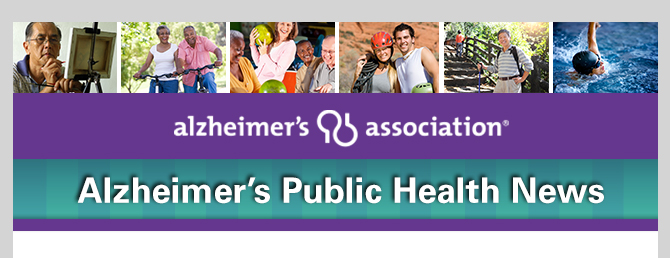


 American seniors may be developing dementia less frequently and at later stages of life, according to new
American seniors may be developing dementia less frequently and at later stages of life, according to new  Nonetheless, this study supports the
Nonetheless, this study supports the 
 Failure to disclose a dementia diagnosis has major ramifications for the health care system, and this study underscores the need for health care providers to discuss a dementia diagnosis with their patients. To begin addressing this issue,
Failure to disclose a dementia diagnosis has major ramifications for the health care system, and this study underscores the need for health care providers to discuss a dementia diagnosis with their patients. To begin addressing this issue,  We encourage you to download your state’s fact sheet not only for your own use, but to distribute to health officials, public health practitioners, and state policymakers. Tweet the fact sheet, link to it on your website, blog about it. Data are only useful when used to inform policy and systems change, and that can only happen if the data are widely distributed.
We encourage you to download your state’s fact sheet not only for your own use, but to distribute to health officials, public health practitioners, and state policymakers. Tweet the fact sheet, link to it on your website, blog about it. Data are only useful when used to inform policy and systems change, and that can only happen if the data are widely distributed.


